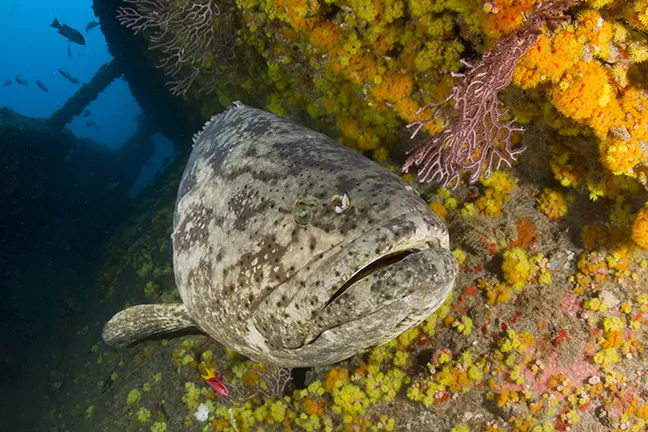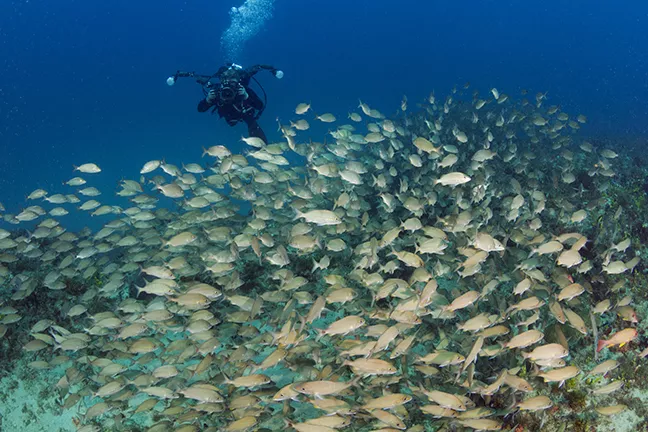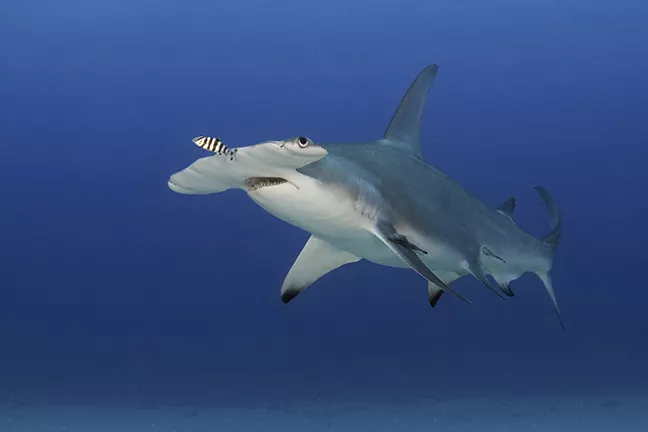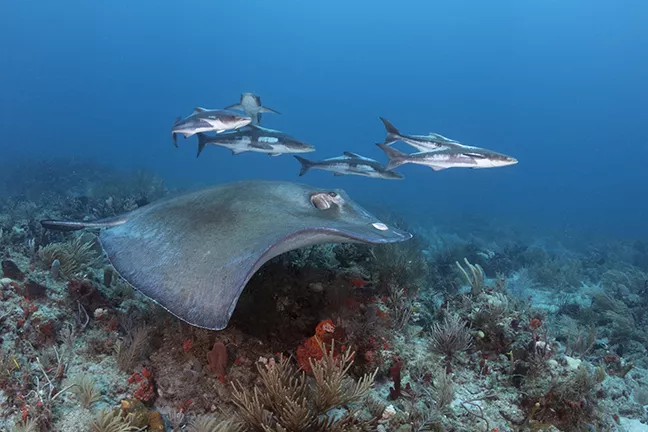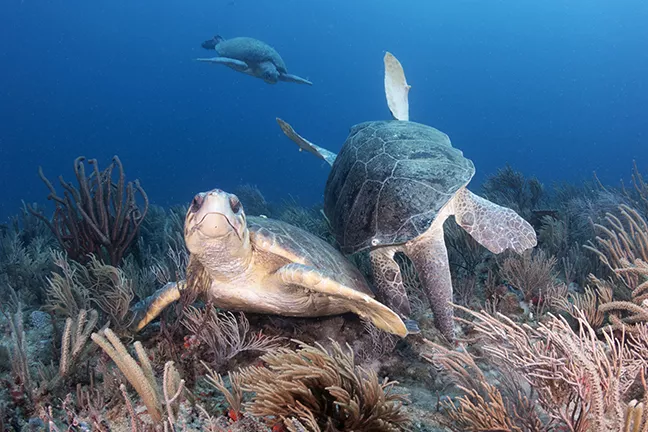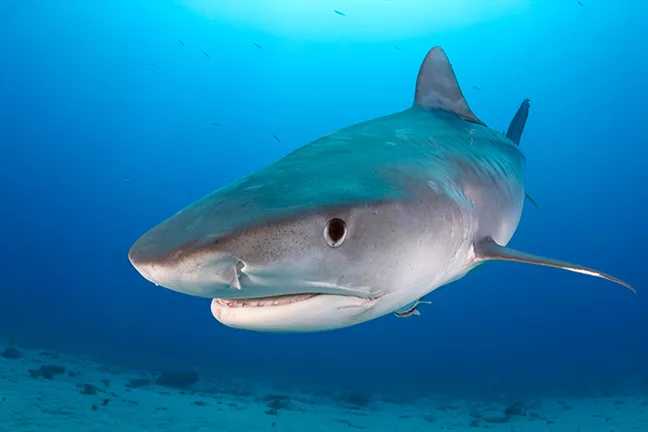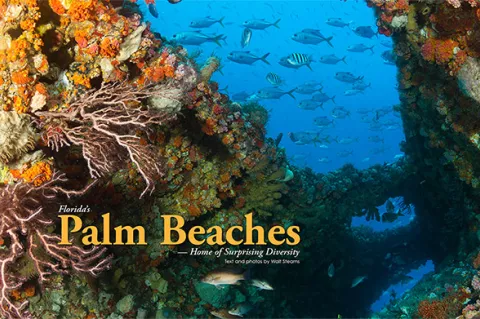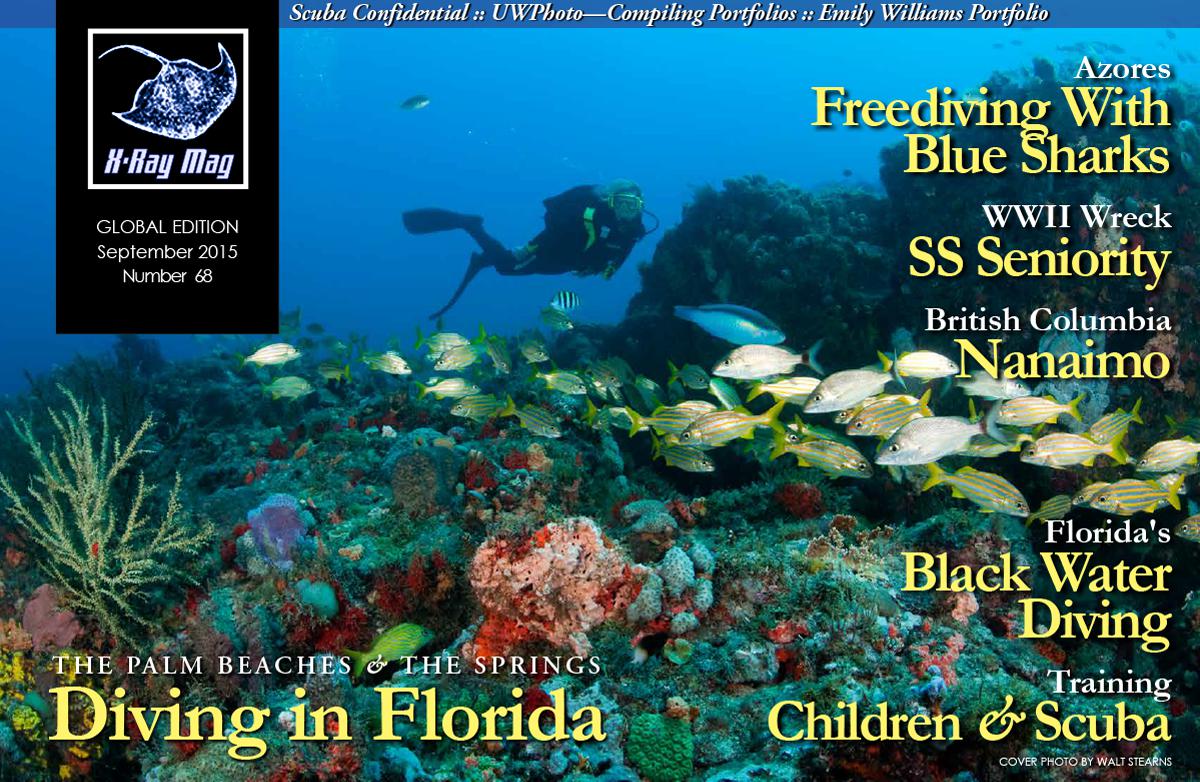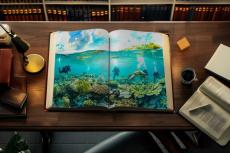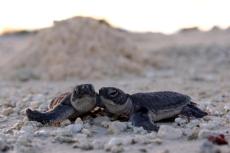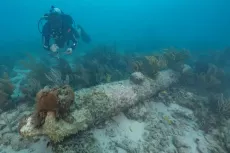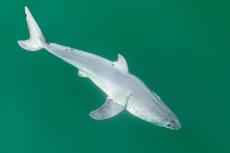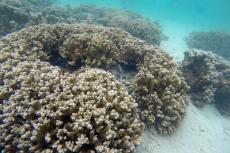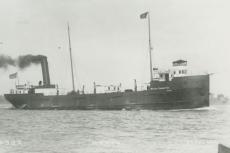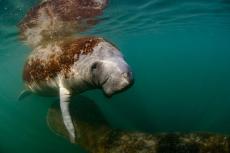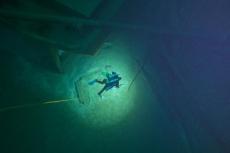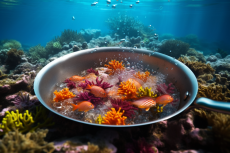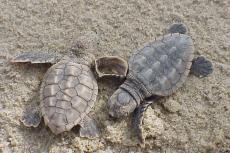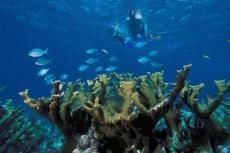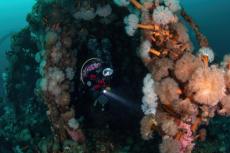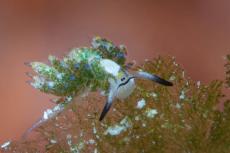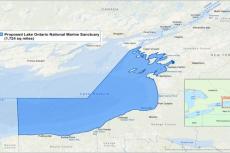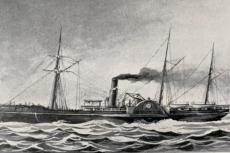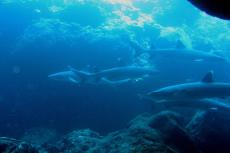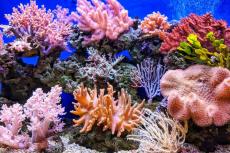When divers look to the horizon for destinations offering marine life of the large variety, they often look to such corners of the world like the Galapagos or Cocos Island, Isla Mujeres, Silver Banks, Tonga, Bahamas' Tiger Beach or Raja Ampat, to name a few. While not as exotic in name, one particular stretch of the US state of Florida’s southeast coast called the Palm Beaches is rapidly gaining recognition as a place to experience large animal encounters.
Contributed by
Factfile
Walt Stearns is a widely published dive writer, underwater photographer, scuba instructor, certified cave and rebreather diver and an SSI Platinum Pro5000 member based in the US state of Florida.
He is the founder and publisher of the Underwater Journal, soon to be a featured blog on X-RAY MAG at: UnderwaterJournal.com.
For more information about the author, visit: WaltStearns.com.
It’s a funny thing about describing a dive destination you have visited versus one you dive all the time. The difficulty for me, is knowing where to begin when attempting to explain what there is to see here by my home in Palm Beach, Florida, to anyone who has never experienced it. What I often get hit with is, “Oh yeah, you do a lot of drift diving there.” While the technique of drift diving is certainly the means which area reefs and wrecks are explored, it is not by any means the main reason to dive here.
What makes the Palm Beaches area so compelling is the marine life. I am not talking about profusions of pretty little reef fish—although we have them here. I am talking about the huge cast of big-ticket show-offs that make the heart skip a beat when they suddenly appear. The list of heavy hitters that call the Palm Beaches home is both long and distinguished, from all five species of sea turtles native to the Atlantic to more than a dozen species of shark. Lemon, bull, reef, sandbar, silky, dusky, tiger and greater hammerhead sharks get top billing. And although rare, encounters with both whale sharks and great white sharks have taken place here. Then there is, of course, the big man on campus—the goliath grouper.
Diving with the ancient mariners
Seeing sea turtles during your dives is still as much a signature trait to diving the Palm Beaches as it was way back when diving first began here. Coming across two or more of these non-threatening and often quite large marine reptiles was so frequent that if you had seen fewer than two during the course of a dive, then it was considered a really slow day. That is because this coastline is one of the few places where all five of the Atlantic sea turtle species—loggerhead, hawksbill, green, leatherback and Kemp’s ridley—are known to converge.
So which sea turtle species are the ones you are most likely to see?
Kemp’s ridley. The first species I will get out of the way is the Kemp’s ridley sea turtle (Lepidochelys kempii), which is a rather small member of the sea turtle clan, measuring 90cm (36in) in length and averaging no more than 45kg (100 lbs) in weight. Due to their general appearance, they are easily mistaken for a young loggerhead. The most tell-tale feature to tell them apart is the carapace (shell) on a Kemp’s ridley sea turtle is both slightly flatter and rounder.
Although found predominantly in the Gulf of Mexico, there is a small population of Kemp’s ridley that live off Florida’s eastern coast between Jacksonville and the northernmost end of the Palm Beaches in Jupiter. So far, I have come across three in all my years of diving off Jupiter.
Leatherback. Another rarity for divers is the giant leatherback (Dermochelys coriacea), a sea turtle which at full maturity can measure over 1.9m (6ft) in length and weigh up to 500kg (1,100 lbs). The largest leatherback recorded was 1.98m (6.5ft) in length and tipped the scales at 915kg (2,019 lbs), making it a colossus in the world of living sea turtles.
While in-water encounters with leatherbacks are fairly rare, meetings with this species do take place, and when they do, there is no mistaking this creature, which has a predominantly black body, with white markings and a teardrop-shaped leathery carapace instead of a hard shell. The answer as to when is the best time to look for leatherback sea turtles begins around early March, as this is the beginning of this sea turtle’s nesting season, which typically ends in June.
The Palm Beaches area is a major breeding and nesting ground for not only the giant leatherback sea turtle but also two other primary species of the Atlantic—the green and loggerhead sea turtles. When nesting season reaches its peak in May and July, the south Florida coastline plays host to more sea turtles per acre than anywhere in the southeastern United States or the Caribbean.
According to the data compiled each year by the Loggerhead Marinelife Center, which records and monitors 9.5 miles of beach in northern Palm Beach County alone, researchers often see the number of sea turtle nests in excess of 10,000 per season.
So far, this season, 2015, is shaping up to be a banner year, with over 9,700 loggerhead nests, green sea turtle nests coming in at 3,616, followed by 213 leatherback nests, for the months of March through July alone. And the season is still not over.
Green. For the most part, green sea turtles (Chelonia mydas) are highly transient and only converge in numbers during their nesting season, which runs from May through September. Easily identified by their smooth, olive-brown carapace (shell) marked with darker streaks and/or spots, and equally smooth bullet-shaped head, green sea turtles are not only large, averaging 190kg (240 lbs), the males can get quite amorous. Oftentimes, their quest to mate can get so heated that they will sometimes pursue the wrong species, giving resident loggerheads and hawksbill sea turtles a fit, while at the same time providing a show for divers.
Loggerhead. Since the loggerhead sea turtle (Caretta caretta) nesting season pretty much overlaps that of all the other species—beginning as early as March and ending as late as August—any time of year is good for seeing them. That is because there is a very large resident population of loggerheads here to begin with, a feature which has made them a signature attraction to Palm Beach diving.
When it comes to looks, these darlings of the reef may not win a beauty contest, between their thick, rough-textured shell and large, blunt head, which looks like the end of a log, hence the name—but they are impressive. Even next to a giant leatherback, they are the second largest turtle found here, with a carapace length of around 1.2m (4ft). A fully mature female will average between 158-204kg (350-450 lbs) in weight.
Diving the reefs in the 15 to 24m (50 to 80ft) range, like Breakers Reef straight offshore at Palm Beach Island during the height of nesting season (late May-June), it is not unheard of to count as many as 20 to 30 adult loggerheads scattered about the bottom during the course of one dive.
Most will be females, recovering from the physical expense of hauling their large bodies out of the water and up a sandy slope in the night to dig a hole deep enough to bury the 100-plus eggs they will lay, only to drag themselves back to the sea to repeat the ritual ten days later.
The most telling evidence of their fatigue is the fact that you will find most of these ol’ girls so bugged out from exhaustion that they will barely make it to the reef before falling asleep in their tracks. Even more comical are the ones that make a poor attempt in parking their large bodies, like a large truck in a small tool shed, with only their heads concealed under small overhangs while the rest of their massive bodies remain exposed to the world.
Hawksbill. Another highly abundant species of sea turtles off the Palm Beach coastline is the Atlantic hawksbill (Eretmochelys imbricata). Next to loggerheads, hawksbill sea turtles are a smaller and more agile species, identifiable by the ornate coloration of their shells and protruding upper jaw, with strong resemblance to a hawk’s beak.
Often, divers will come across one using that specially-designed beak to dig into and tear small chunks from a sponge. Hawksbill sea turtles are basically spongivores, feeding on sponges as a primary part of their diet, which also explains why they are a common feature to Palm Beach reefs.
The one thing I find interesting is that unlike leatherbacks, green and loggerheads, hawksbill sea turtles rarely nest here, as most of these turtles encountered are largely adolescent individuals, measuring less than 60cm (24in) in length. Once in a while, I will come across a fully mature turtle in the 91cm (36in) range, weighing as much as 86kg (190 lbs), but these I tend to write off as transient turtles just passing through.
Shark Alley
Seeing a large shark adds excitement to any dive, which is something the waters of Palm Beach feature. The most common members of “the guys in the grey suits” likely to be seen comprise nurse, Atlantic reef, lemon and bull—in that order.
Several of the reefs up between Jupiter and North Palm Beach—like Shark Canyon and Tunnels—are regular stomping grounds for Atlantic reef sharks (Carcharhinus perezii). Dive charters do not feed these sharks, as it is not permissible to do so in state waters. The sharks are at times inquisitive, granting a lucky photographer a good photo op now and then. One of the interesting behaviors I have seen these sharks do, from time to time, is taking naps beneath overhangs provided by the edge of the reef.
Lemon sharks. A personal favorite of mine is the lemon shark (Negaprion brevirostris), which also cruises the same primary reef system running parallel to the coast at depths between 14-18m (45-60ft) and 21-30m (70-100ft). Measuring up to 2.4m (8ft) long, weighing as much as 136kg (300 lbs), these big brawny fellows (actually most are females) have all the baring and looks of a pretty serious customer. Yet, comparing them to a species like the Atlantic reef shark (the species common to most shark dives in the Bahamas) they are not highly excitable, but rather, they come across as better-behaved. Which is a good thing, because they are the least bashful about coming in real close to photographers.
I really got to know one particular shark back in January 2001 when I came upon something I had never seen before—over 40 of these sharks, all adult in size, resting on the bottom in formation like cars in a parking lot. Upon contacting Dr Samuel Gruber—one of the world’s most renowned experts on lemon sharks—he confirmed that this particular aggregation behavior was one-of-a-kind, unknown to occur anywhere else in the world, setting into motion a highly extensive study under the auspices of Doc Gruber’s Bimini Shark Lab. The information from the Jupiter Lemon Shark Project was able to fill in new chapters about this shark’s natural history that were previously unknown.
A by-product of Dr Gruber’s work in 2010 became an instrumental part in the State of Florida passing into law complete protective status for lemon sharks in state waters. The main premise for this action was based on the shark’s slow growth rate, reaching sexual maturity at 12 to 15 years of age.
Illustrating just how susceptible lemon sharks are to overfishing, reproduction in this species takes place every second or third year at most, at which time the given number of pups in a litter averages between six and 18. Add to that a juvenile mortality rate of 40 to 60 percent in the first years of development, the research findings point to a very low recruitment rate for the species.
Blacktip sharks. The lemon shark’s aggregating behavior I first witnessed back January 2001 is not the only that takes place. One of the most dramatic is the annual migration undertaken by a variety of blacktip shark called a spinner (Carcharhinus brevipinna)—so named for their tendency to spin as they jump into the air. These sharks work their way down the North American coastline for the same reason birds fly for winter. By the end of December, schools of these relatively small sharks (averaging 1.5m, or 4ft, in length) number in the hundreds, converging in the warm, near-shore waters of the Palm Beaches.
To give an idea of just how numerous these sharks are in migration, Florida Atlantic University (FAU) Associate Professor Stephen Kajiura—who’s primary field is the migration habits of spinners—uses aerial photography for a large part of his counting work. Through this technique, Dr Kajiura was able to tabulate that between January to the end of April, there can be as many as 500 sharks per square kilometer along the beach from the surf line out to half a mile offshore.
The reason so many sharks end up here is based on two adjoining factors. The first is the unique nature of the Palm Beach coast’s underwater topography, which features the narrowest continental shelf anywhere along North America’s eastern seaboard.
If you were to follow the bottom contours of this shelf 81km (50mi) north of Miami, you would find that it will become increasingly narrower the further north you travel. Marking the edge of the shelf, depths average 30 to 40m before dropping quickly to depths well past 500m. By the time you reach the same latitude as the city of West Palm Beach, the shelf will have reached its narrowest juncture, spanning less than 4.8km in width.
Adding to this is the geological position, that the area also happens to be the easternmost point of land in all of Florida, placing it squarely in the path of the Gulf Stream as it pushes north. So, when sharks move up or down the coast, the narrow shelf acts a little bit like a bottleneck, causing them to concentrate in greater numbers where water temperatures are most desirable.
Diving with sharks
When it comes to diving with sharks, the subject becomes a matter of personal preference. Some operations like to promote it, whereas some would rather see as little of them as possible. But, if you are the type that likes to dive with sharks, one thing is certain here in the Palm Beaches, it can be arranged.
Most shark dives are conducted out near the reef as well as on the edge of the shelf, four to seven miles offshore of northern Palm Beach County in the Jupiter/Juno Beach area. And I would not recommend them for beginners as bottom depths run between 27m (90ft)and 36m (120ft) plus, so half of the time you are in the water, the bottom can be pretty far below you. But out in this zone, the cast of players can be as numerous as they are varied, with lemon, bull and silky sharks making up the core candidates, usually followed by dusky, sandbar, tiger and greater hammerhead sharks making their special appearances.
Goliath groupers
Should requiem sharks not be of your preference, may I introduce you to the goliath grouper?
The goliath grouper (Epinephelus itajara) is not named after the biblical story of the giant slain by David, but for their robust size. A full-grown goliath can, at times, exceed a quarter ton in weight, measuring up to 2.1m (7ft) in length, easily making them the largest tropical reef-dwelling bony fish in the world. When confronted by one, this fellow will command your attention.
Despite their formidable size and somewhat dense demeanor, goliaths are not the ferocious brutes some spear fishermen would like you to believe. For the most part, they can be big babies, with most habitually retreating to a safer distance or disappearing down into a hole on a wreck the moment they feel threatened. Now and then, a bolder fish might sound off with a short series of loud booms, but that behavior is typically all bark and no bite.
Now and then, there will be a few fish that will move towards a diver. Local underwater photographers refer to these more inquisitive and social fish as the “super models”, eagerly puckering up for the camera while the photographer fires off shot after shot. Where the fish are this compliant, you can do almost anything short of giving it a bear hug.
If you happen to meet one of these fish, there are a few simple rules to follow:
1. Keep your movements slow and deliberate, as they also don’t like being surprised.
2. Don’t put your hands in front of its face as it could result in the fish biting you.
3. Don’t chase the fish. Your best results will come by following rule #1.
Over the course of the past five years, diving with goliath groupers has grown to become such a significant signature trait of Florida’s entire Palm Beaches region that the gentle giants just about eclipse all other attractions.
Finding one is pretty much a guarantee, as most wrecks, along with a few stretches of reefs, have a permanent resident population. Drop in on one of the wrecks like the Zion Train or MG-111 off Jupiter, or Castor down south off Boynton Beach, and you should find no less than eight to 12 of these barrow-shaped behemoths. Likewise, on the Mizpah of Danny Wrecks off West Palm Beach, you will find at least four to five goliath groupers at each wreck most of time.
Things really start to get exciting towards the end of July, as the late summer months of August and September are the fish spawning season. When it comes to going to see these fish spawn, Palm Beach is the number one place in the Atlantic to go to see it happen! Actually, it’s currently the only place to see it happen.
And see it you will, as these behemoth-size fish form aggregations that can exceed 90 or more, between five specific sites that lay within easy reach of dive charters between Jupiter and Boca Raton. The first three, I have already mentioned: MG-111, Zion Train Wrecks and Mizpah—all three dive sites sit at depths of 27m (90ft) or less. Then there is the Castor wreck off Boynton Beach, which sits at 34m (110ft). The fifth site called the Hole-In-the-Wall, located off the coast at Jupiter, is a bit deeper, featuring a depth profile of 36-42m (120-140ft).
In comparison to most other species of grouper, the goliath’s path to romance is more a marathon than a sprint, with some individuals making the journey to their spawning grounds from considerable distances—as far away as 560km (350mi). Once in Palm Beach waters, their romance will take up the entire months of August and September.
The takeaway is the opportunity of getting incredibly close to an entire spawning aggregation of a critically endangered species in one of the most accessible places in the world where underwater visibility can go from good to exceptional—18 to 30m (60 to 100ft). Not only is it a spectacle that sometimes defies words, it also makes for one hell of a photo op.
Back to the question, what is there to experience in Palm Beach? I would think you will find a lot more than: “Oh yeah, you do a lot of drift diving there.”
Gulf Stream effect
Where the Palm Beach coast differs from the Florida Keys is the variety and nature of its coral reefs. Instead of shallow spur and groove fringing reef formations synonymous of the Keys, bottom contours comprise massive, elongated ancient limestone from earlier millennia when sea levels were nine to 43m (30 to 140ft) lower than they are today. Varying in height from 1m (3ft) to as much as 5.5m (18ft) above the sand, these elongated limestone escarpments are far from featureless, which brings us back to the Gulf Stream.
This mighty “river within the sea” is the second largest oceanic current on the planet, which begins down the western Caribbean, with a pathway that takes it up and around South Florida, up the coast and on into the North Atlantic, all the way to the British Isles.
As a result, this massive flow of clear, tropical water tracks closer to shore along Palm Beach County than anywhere else along the North American Continent. This provides the clearest waters divers will encounter in Florida, with underwater visibility reaching the 24 to 30m range.
The proximity of the Gulf Stream does far more than provide divers with inviting water clarity and warmer temperatures in the winter. The Gulf Stream’s constant flow enlivens area reefs, bringing the nutrition needed for corals, sponges and bottom fish life to thrive.
Evidence can be seen most readily on the outlying reefs and wrecks in the 14 to 28m depth range where the presence of colonial sponges, gorgonians and hydra-corals are highly abundant and most varied. The most visual features range from orange elephant ear sponges and deeper-hued orange and red tree sponges to my favorite of the bunch—the red polyp octocorals, with their eye-popping vibrant red to iridescent orange hues. But all that is mere garnishing on the plate when you see what the main entrée has in store.
Between these two adjoining factors (the width of the shelf and the presence of the Gulf Stream), coastal waters of Palm Beach serve as an oceanic highway of sorts for a multitude of open ocean and migratory species of marine life from sharks to jacks, mackerel, tuna, billfish and sea turtles to the less expected, like the large ocean sunfish (Mola mola) or passing humpback and North Atlantic right whales.
Drift diving
The Gulf Stream influences almost every aspect of diving along the Palm Beach coast, from what you see to how you actually dive it.
The primary practice is the “live boat” method in which the boat, between deployment and recovery of divers, follows the divers overhead while they travel with the current exploring the reef or wrecks.
Here’s how it works: As the boat gets close to the intended dive site, divers are given a 10-minute warning to gear up. Once there, the captain lines up the boat a short distance up-current of the intended reef tract or wreck. Once in position, the boat is put in neutral and a jumpmaster-style type command of “Dive, Dive, Dive” is issued. The dive group steps overboard and begins their descent.
At this point, they will not feel any effects of the current, because both they and the boat are moving with the flowing water. It is only as they approach the bottom, they will begin to notice that they seem to be flying over the ground, at speeds that could range from barely describable to brisk, depending on the location and the nature of the currents on that particular day.
Once settled, near the bottom, divers can relax and allow the current to do most of the work, while staying in visual range of the divemaster and/or group leader who carries a tethered surface float. This style of diving actually requires less exertion than diving on a reef or wreck with no current, and divers are able to cover long distances following the reef contours as they go, thereby increasing their odds of seeing the region’s big-ticket items.
At the end of the dive, there is no need to fight the current to get back to the anchor line, or remember where the boat is. Instead, the group simply heads for the surface, performing a safety stop along the way, and the boat comes to them for re-boarding. The process is surprisingly simple, convenient, and most of all, a lot of fun!
Where to dive
—Palm Beach coast departure points
Palm Beach County’s 72km (45mi) long coastline is divided up between four inlets where local dive charters are based and from which divers are able to access a large number of sites several miles in either direction of those corresponding inlets. Starting at the southernmost end of the county, the four inlets are located as follows:
Boca Raton Inlet – Situated on the southernmost point of Palm Beach County, dive operations have the unique advantage of not only addressing many of the same wrecks and reefs that sit within reach of the Boynton and Delray Beach area, but also several of Broward County’s famed collection of wrecks offshore of Pompano Beach.
Boynton Inlet – Also called South Lake Worth Inlet, this inlet provides access to the southern half of Palm Beach County, with its own collection of reefs and wrecks for divers to explore off Boynton Beach, from Lantana south to Delray Beach.
Lake Worth Inlet – Located nearest to the city of West Palm Beach, this large inlet cuts between Singer Island and Palm Beach Island, providing access to a large reach of both northern and central Palm Beach County’s reefs and wrecks.
Jupiter Inlet – This inlet is located at the most northern end of Palm Beach County, providing direct access to both Jupiter and Juno Beach’s prime collection of wrecks and reefs. ■
REFERENCES:
www.marinelife.org

